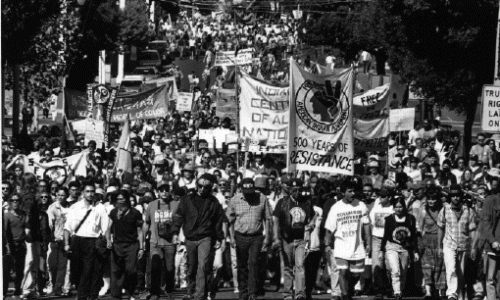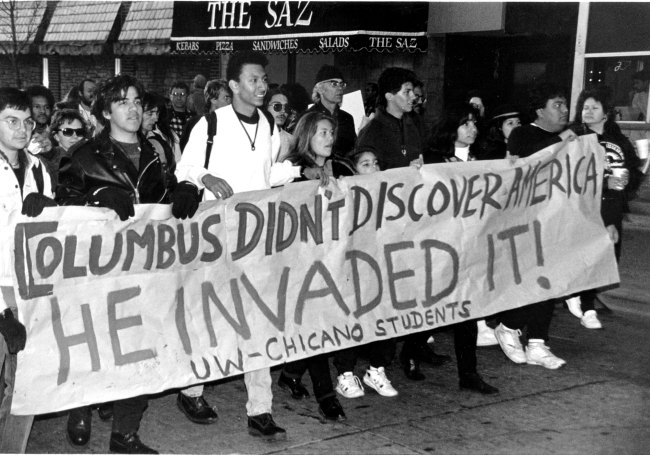
What is it about Columbus Day that always makes me stop to consider my own identity? Maybe it’s because it’s an easy way to illustrate what I mean about having multiple personalities on being an “American” (be prepared, there are going to be lots of “air-quotes” used in this short piece). This duality about who Columbus was and what Columbus Day means to me, probably became most clear in 1992, during the 500th anniversary of Columbus’ landing somewhere in the Caribbean, when I was visiting for the first and, thus far, only time, my father’s homeland of Ecuador.
Here in the United States, there were plenty of demonstrations and other gatherings meant to highlight how some of the indigenous groups felt. While one side celebrated the “discovery” of the “new world”, the other side lamented the “incursion” on their world. It was a time to reflect on what had happened half a millennia ago, and how the world we live in today was shaped by those events.
One of my favorite reflections on the topic remains Barry Lopez’s The Rediscovery of North America, and I think it should be required reading as we head forward in history still being shaped by powerful corporate interests with only economic considerations as their bottom lines; where the world and everything in it, including other human beings, are seen as “natural resources” meant for the rich and affluent to exploit to further fill the coffers they will pass along to their progeny. Don’t forget that Columbus’ voyage, while partially backed by the king and queen of Spain, was for all intents and purposes a financial investment meant to make a profit. His desire to find a trade route to the East while travelling west was also precipitated by the fact that many ports and harbors in the Mediterranean, Black and Caspian Seas as well as those in the Persian Gulf and Indian Ocean, were controlled at the time by Muslims who did not have good relations with many European city states.
That summer in 1992, I spent traveling with two of my best friends, through a land that was foreign, yet somehow familiar. Ecuador, being further south than where Columbus and his men landed, and facing the Pacific, became colonized by the Spaniards rather than the British, and it is why I spoke Spanish at home before learning English from Sesame Street and public school. In Ecuador too, that summer, the people there were reflecting on what had started with Christopher Columbus’ arrival in 1492. Everywhere we travelled there were murals depicting what most were calling “the incursion”, “the invasion”, “the attack”. Some of the murals depicted natives bowing down before the Europeans or carrying gifts as tribute to the strangers. One mural showed Columbus holding a severed head in one hand while standing atop a pile of bodies. It was uncomfortable to see such images in full color splayed against the building walls.

Aside from providing teachers and students, including myself, with a day off from school, Columbus Day really is my least favorite “holiday”. By now, many people have been relieved of most of the myths associated with the famous sailor. People in his time didn’t believe the Earth was flat, and he certainly wasn’t the “first” person or even European to “discover” the new lands that would come to bear not his name, but that of his fellow “countryman” and cartographer, Amerigo Vespucci.
Despite his fame and infamy, there is still much that people don’t know about Christopher Columbus. Thus, here then are some facts and observations I find fascinating about the man whose name and legend are celebrated on the second Monday of October.
- Technically speaking, Christopher Columbus was not “Italian”. He was born in Genoa, which at the time was a small, independent city center; one of many left over after the fall of the Roman Empire. Modern Italy wouldn’t come into existence until 1861, so calling Christopher Columbus an Italian, is like calling Sitting Bull a South Dakotan.
- Christopher Columbus never made it to the one “America” that celebrates him. His first and second voyages explored Hispaniola, (Haiti and the Dominican Republic) Cuba and other islands in the Caribbean, while his third voyage got him to the north coast of South America and his last one made it to Central America.
- Despite never finding cinnamon, turmeric, ginger or cardamom, and never seeing tigers or elephants or a single city that resembled anything described by Marco Polo or any previous European adventurer, Christopher Columbus reportedly died absolutely convinced that what he had stumbled upon was most definitely, absolutely, just had to be … the Far East. Others would soon prove him very, very wrong.
- The reason we’re Americans and not Colombians (except for those of you from Colombia, of course) is because a German cartographer named Martin Waldseemuller published a map in 1507 crediting a Florentine, Amerigo Vespucci, with the “idea” that the lands which Columbus happened upon represented a new, heretofore unknown continent.
- For someone who didn’t think he had “discovered” new lands, but had simply found a westward passage to the Far East, Columbus sure was quick to re-name every place he landed and everyone he encountered.
- Even though Christopher Columbus gained fame during his lifetime, there are no confirmed contemporaneous portraits of what he actually looked like. Thus, all of the images that we have of him are “as imagined” by artists.
- Although various accounts have sailors on the Pinta signaling they first spotted land on October 12, 1492, Christopher Columbus would later state that he first spotted the land from his boat, the Santa Maria and therefore claimed the reward for whoever first saw land.
- Columbus wrote two books, including one called the Book of Prophecies in which he uses a handful of Biblical verses to interpret the meaning of his voyages.
- Despite claims that Columbus died broke and destitute, this is really a matter of perspective. According to the entry in the Encyclopedia Britannica, “Nonetheless, it would be wrong to suppose that Columbus spent his final two years wholly in illness, poverty, and oblivion. His son Diego was well established at court, and the admiral himself lived in Sevilla in some style. His “tenth” of the gold diggings in Hispaniola, guaranteed in 1493, provided a substantial revenue (against which his Genoese bankers allowed him to draw), and one of the few ships to escape a hurricane off Hispaniola in 1502 (in which Bobadilla himself went down) was that carrying Columbus’s gold. He felt himself ill-used and shortchanged nonetheless, and these years were marred, for both him and King Ferdinand, by his constant pressing for redress.”
Whether you think Columbus was a hero or not, his voyages changed everything about the world. Suddenly there was another half of the world that NO ONE knew existed.
Thank you for stopping by and I hope you have a great Columbus Day.
Copyright © henry toromoreno, 2013. All rights reserved.

